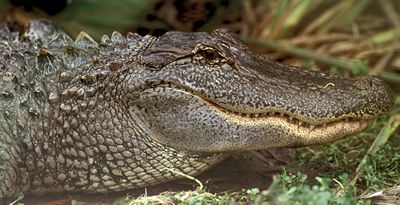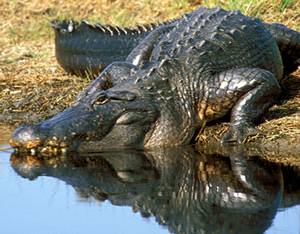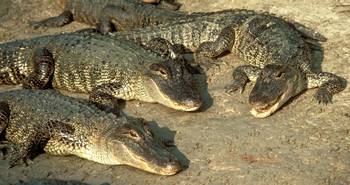American Alligator (Alligator mississippiensis)

TPWD © Earl Nottingham
- Description
- The American alligator is a large, semi-aquatic, armored reptile that is related to crocodiles. Their body alone ranges from 6 - 14 feet long. Almost black in color, the it has prominent eyes and nostrils with coarse scales over the entire body. It has a large, long head with visible upper teeth along the edge of the jaws. Its front feet have 5 toes, while rear feet have 4 toes that are webbed.
For more information, see the alligator pages. - Life History
- An agile swimmer, the American alligator often floats or swims with only its eyes and nostrils exposed. Alligators are carnivorous, and will eat anything they can catch, including fish, turtles, lizards, snakes, small mammals, water birds, crustaceans and other alligators. They can be very vocal; the young typically make a bark and adults will bellow, grunt, or hiss, depending on the circumstances.
Alligators in Texas are mostly inactive from mid-October until early March. March through May is the alligator's peak time for breeding and nesting. During breeding season, females stay close to home territories while males may occupy ranges up to ten square miles. The female will build a nest of local vegetation up to 6 feet across and several feet high. She lays her eggs in the center of this mound, allowing the decaying vegetation and sunlight to provide the warmth necessary to incubate the eggs. Females typically lay over 35 eggs. Each egg is about 3 inches long. The eggs incubate for about 2 months, and the female will watch and defend the nest during this time. As the young hatch, they "yip" and the female will assist them by digging them out of the nest. Hatchling alligators are about 9 inches long and will stay near the female for up to two years. The female will continue to protect the young during this period.
American alligators normally avoid humans, but they can become perceived as a nuisance when they establish territories around people. As human populations in Texas continue to expand, there have been an increased number of encounters between people and alligators. Alligators have been known to prey on pets and must be treated with caution. Alligators can be surprisingly quick on land and are capable of running quickly over short distances. - Habitat
- Alligators are found in or near water. They are common in swamps, rivers, bayous, and marshes. While typically found in fresh-water, they can tolerate brackish water as well.
- Distribution
- The American alligator is found throughout the southern U.S., including the eastern third of Texas.
- Other
- The American alligator, Alligator mississippiensis, once on the verge of extinction, has made a tremendous come-back over the past 30 years. In 1969, Texas provided complete protection for the American alligator and classified it as endangered after passage of the Texas Endangered Species Act in 1973. Under this protection, along with Federally implemented regulations eliminating unregulated alligator hide markets in the United States, the species has made a full recovery and was delisted from the status of endangered in 1985. The alligator is now a protected game animal in Texas. Special permits are required to hunt, raise, or possess alligators.

TPWD © Earl Nottingham

TPWD © Mario Gonzalez
For more information
- For additional details about alligators, and how to deal with them, go to the alligator pages.